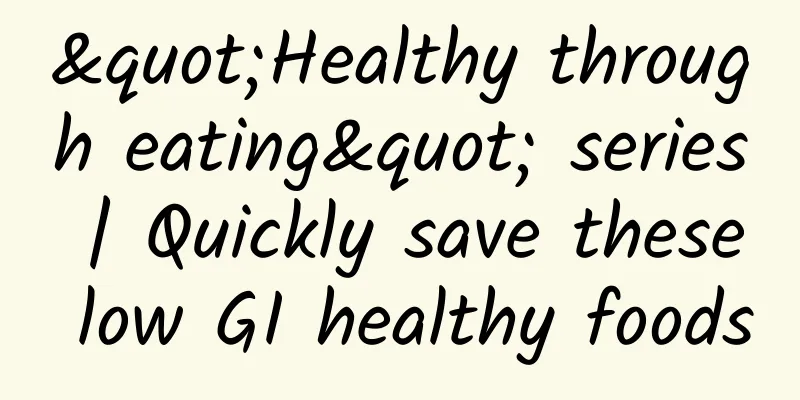"Healthy through eating" series | Quickly save these low GI healthy foods

|
Controlling blood sugar is a long-term compulsory course for people with diabetes. Understanding the carbohydrate content and GI value in food is very helpful for blood sugar control. What is GI value? The glycemic index, or GI, is an indicator that measures the blood sugar response caused by food after a meal. The glycemic index ranges from 0 to 100, with the reference food being glucose (glycemic index = 100). The higher the glycemic index of a food, the greater its impact on blood sugar (rapidly increasing blood sugar levels). "Sweet traps" are everywhere in life Staple food: rice > white wheat buns > glutinous rice > pancakes > mashed potatoes > white bread (high GI) Cornmeal porridge > Chinese yam > boiled taro > corn tortillas > macaroni > three-fresh dumplings (low GI) Fruits: watermelon > mango > banana > kiwi > orange > plum > grapefruit > cherry Vegetables: Pumpkin > Carrot > Potato (cooked) > Sweet Corn (cooked) > Sweet Potato > Green Peas > French Beans > Soybeans Snacks: processed meat foods such as meat jerky, dried meat, and fish fillets; some dried bean snacks; dried fruit snacks; pickled processed foods Eat more low GI index foods Foods with a high GI are digested and absorbed quickly after entering the stomach, and blood sugar fluctuates greatly. When blood sugar is high, the body produces insulin, and the undigested sugar will be converted into fat, which will make you feel hungry and eat more. Low GI foods, on the contrary, are slowly digested and absorbed, blood sugar fluctuations are relatively stable, intestinal motility is promoted, and the feeling of fullness provided by the food is more lasting. Factors that affect the GI value of food The GI value of food is not fixed, and some factors can also affect the GI value of food. For example: the degree of gelatinization of food (oatmeal porridge > oatmeal rice), the degree of food processing (corn flakes > corn), the degree of food integrity (orange juice > orange), the degree of food maturity (ripe banana > normal ripe banana), the cooking time of food (30min > 20min), the acidity of food (ordinary noodles > noodles with appropriate amount of vinegar) How to avoid high GI foods 1. Shorten the processing and cooking time. The longer the food is processed, the higher the gelatinization degree, the faster the absorption, the higher the glycemic index, and the faster the blood sugar rises. Therefore, reduce the consumption of processed foods, the cooking time should not be too long, and the staple food should be eaten dry instead of watery. Reduce the consumption of processed foods, and remember that coarse grains should not be cooked finely. 2. Eat directly. Especially fruits, do not squeeze juice or mash them into paste, just eat them directly. 3. Pay attention to the type of meals you eat, and mix and match them. Eat a combination of high and low GI foods. Staple foods are generally medium-to-high glycemic index foods. You can choose to pair them with vegetables and proteins with low glycemic indexes to delay the increase in blood sugar after meals. 4. Pay attention to the total amount. Low GI does not mean low calories or low carbon water. Excessive consumption of low GI foods can also lead to excessive carbohydrates and calories. When eating, be careful not to eat too much of any food to avoid exceeding the total intake. Daily tips to lower GI 1. Arrange the order of eating: The recommended order of eating is: soup, vegetables, meat, staple food. That is, put a bowl of clear soup first, then eat vegetables, then eat meat, and finally eat staple food. Coarse grains are also recommended for staple food, preferably the size of a fist. A slight interval between the main and side dishes is conducive to lowering the glycemic index and controlling blood sugar after meals. 2. Low GI substitution method. Replacing some high GI foods with low GI foods, or eating high and low GI foods together, can also help increase the balance of nutrients. For example, replace white flour steamed buns with multi-grain steamed buns. Author: Liu Jiayi and Lei Zhiyuan from Luoyang Normal University Review expert: Ren Yongqiang, professor/chief physician of the First Affiliated Hospital of Henan University of Science and Technology |
<<: “Health from Food” Series | Does Excessive Eating of MSG and Chicken Stock Cause Cancer?
>>: Winter dressing secrets revealed: Turtleneck sweaters may cause health problems
Recommend
How long does it take to claim maternity insurance?
Nowadays, when many people sign up for work, the ...
MIT: Research shows news coverage accelerates Twitter growth
MIT investigated the "contagion process"...
Why is it that my period has not ended for ten days?
Menstruation is another name for female menstruat...
What are the common gynecological diseases and symptoms?
Gynecological diseases are a general term for wom...
What are some home exercise methods for women?
Among women who sit in the office for a long time...
Symptoms of uterine cold
Uterine coldness is a dialectic of TCM theory, wh...
Blood clots 11 days after medical abortion
There are generally two situations in which blood...
What are the health benefits of loquat? How to peel loquat
Loquat is rich in nutrients and can be eaten in a...
How effective is Sichuan pepper water in treating cervical erosion?
Cervical erosion is troubling many women. I belie...
Is it normal to have no bleeding after a painless abortion?
The absence of bleeding after a painless abortion...
Vaginal bleeding during bowel movement
The vagina is a very important reproductive organ...
How to open almonds? When are almonds ripe?
Almonds are also called almonds, and are also com...
How do you know if you have uterine cold?
A healthy body is a goal that no one pursues. Wha...
How to choose the time for induction of labor?
Induced abortion is a surgery that must be perfor...
Will having myopia surgery cause presbyopia to develop earlier?
People who have undergone eyeglass removal surger...









